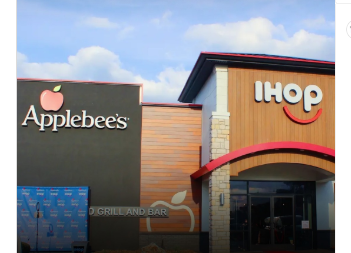IHOP and Applebee’s are combining under one roof to create what their parent company, Dine Brands Global Inc., refers to as a “dual-branded restaurant.” This is a startlingly audacious development for the casual dining industry. By providing two meal moods in one location, this partnership is a remarkably successful experiment in reshaping the customer experience rather than just a cost-cutting measure.
A common area and an adaptable structure serve as the foundation for the fusion. Both menus are available once guests enter through an IHOP entrance or choose the Applebee’s side. From syrup-drenched breakfast orders to late-night burgers and cocktails, Dine Brands hopes to dramatically boost traffic throughout the day by utilizing this integrated design.
IHOP x Applebee’s Dual Concept Overview
| Brand Initiative | IHOP x Applebee’s Dual-Branded Restaurant |
|---|---|
| Parent Company | Dine Brands Global Inc. |
| First U.S. Location | Seguin, Texas (Launched February 2025) |
| Menu Structure | Two full menus + five exclusive hybrid dishes |
| Dining Design | Dual entrances, separate dining zones, shared kitchen and staff |
| Target Demographics | College towns, suburban families, urban brunch-goers |
| Standout Features | Brunch cocktails, all-day breakfast, happy hour classics |
| CEO Statement | “A compelling opportunity for further growth” – John Peyton |
| Source Link | CBS News Coverage |
A Two-Tempo America with Two Menus
The idea, which has already been tried out abroad, is now making its way to the US with a plan that works especially well in areas where both brands have devoted fan bases. Customers in Texas, the pilot’s launch state, were not only open to the idea, they were excited about it. Erin McDowell of Business Insider said the experience was “surprisingly cohesive,” combining the casual charm of Applebee with the breakfast warmth of IHOP.
The model provides round-the-clock appeal and streamlines staffing by combining a shared kitchen and front-of-house team. The dual-format layout ensures that both cravings can be satisfied under one roof, removing any conflict between meal types and mealtime conventions, whether you’re craving chicken wings at noon or a stack of pancakes at six o’clock.
Combining Brand DNA Without Identity Diluting
This merger offers a very clear example of balancing two different culinary voices without erasing either one in the context of brand management. The familiarity, comfort, and round-the-clock breakfast that define IHOP’s identity contrast surprisingly well with Applebee’s more lively, bar-forward atmosphere. Imagine an evening burger topped with a mimosa or pancakes served with spinach dip on the side.
The hybrid design of these new eateries fits in well with a lifestyle characterized by flexible schedules and impromptu dining, particularly for Gen Z and millennials. This dual-concept restaurant responds to the shift in traditional meal windows caused by remote work and flexible schedules by offering significantly better availability and variety, which makes it much more responsive to customer demands.
Taking on Skepticism with Meaning
The announcement has, of course, generated a range of responses on the internet. The culinary contrast was questioned by Reddit and X users, some of whom saw it as a mismatch in branding. The operational logic, however, is sound underneath. Breakfast is the most popular meal from the morning until the early afternoon, while dinner and happy hour take center stage in the evenings. By combining the two, each brand can compensate for the other’s downtime, resulting in a very effective use of both labor and space.
“It’s about merging foot traffic, not merging menus,” one commenter noted. And that may be the most significant metric of all from a business perspective.
Savoring Innovation with a Hint of Nostalgia
The IHOP-Applebee model creates opportunities for especially creative partnerships in menu development. The possibilities of hybrid comfort food are hinted at by early exclusive dishes like loaded brunch burgers and buffalo omelets. The same culinary curiosity that led to the success of Taco Bell’s Doritos Locos Tacos and McDonald’s All-Day Breakfast pivots is tapped into by these crossover items.
Additionally, these new hybrid venues offer something for everyone without sacrificing quality or service, making them incredibly dependable choices for brunch aficionados, families, and late-night diners alike.
Casual Dining Enters a New Era?
Before expanding to other areas in the upcoming years, Dine Brands intends to keep a careful eye on performance. However, the groundwork has been established. This merger is more than just a corporate mashup; it’s a deliberate evolution created to fit the times through data-backed menu pairings, cost-effective buildouts, and strategic location planning.
The dual-branded format maximizes the use of marketing budget, delivery logistics, and kitchen infrastructure by optimizing operations and releasing operational bandwidth. It’s a model that other restaurant chains might eventually follow, particularly in an environment where adaptability is now required rather than optional.
The Last Bite: A Familiar Fusion
In the end, the merger of IHOP and Applebee isn’t about combining two distinct identities into one. The goal is to provide diners with the pleasure of choice without the stress of indecision while converting underutilized dining hours into opportunities for income.


